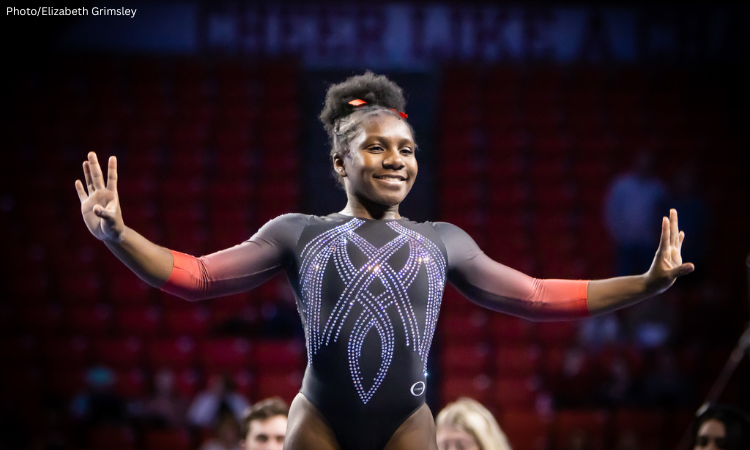On paper, each of the four events is equally important to a team’s success–each carries a maximum potential score of 50.0, and a good score on one event is worth just as much as a good score on another. However, from the viewer’s perspective, one event may appear to be more critical than another. For instance, we often hear about the advantage that a lineup of strong 10.0 vaults can give a team over one competing mostly Yurchenko fulls, and the importance of a solid beam rotation cannot be understated. This begs the question: is there one event that edges out the others in determining a team’s success? We looked to data from the 2023 season for answers.
Final Team Ranking Compared to Final Event Ranking
Overall, a team’s rank on any given event is closely related to the team’s overall ranking. Top-ranked and lower-ranked teams have more aligned rankings, as seen in the tighter clustering in the bottom left and upper right corners of each graph, while mid-ranked teams have more variation in their comparative rankings.
The pink line through each graph represents the overall trend line for each event. While all of them are nearly a perfect diagonal – a 20th overall ranking is equal to being ranked 20th on beam, for example – the relationship is strongest with the uneven bars. In other words, a team’s final ranking on the uneven bars is the most likely event ranking to align with the team’s final ranking. This plays out the same way regardless of where teams were ranked. Top teams like Oklahoma, Florida, and Michigan; teams in the middle, like UC Davis and Pittsburgh; and lower ranked teams, like Alaska and Fisk, all had overall rankings that were similar to their final standings on bars.
The line is also helpful to gauge under and overperformers on individual events as compared to their overall team ranking. Points above the line are teams whose event ranking is lower than expected for their team ranking position while points below the line are teams whose event ranking is higher than expected.
On vault and floor, a notable overperformer is Illinois State, which finished 52nd overall, but 33rd on vault and 35th on floor. This was thanks to strong contributors on both events, such as Jaye Mack with her 9.8 NQS on vault and 9.905 NQS on floor and Alana Laster with her 9.89 NQS on vault and 9.84 NQS on floor.
Minnesota, on the other hand, struggled on beam all season and finished 40th on the event, a very different number than its 18th overall ranking. Its NQS was only 49.02 and it struggled with consistency, including counting two falls at Big Fives following a devastating season-ending injury to Brooklyn Rowray.
Of the top 20 teams from 2023, seven had an event score that was more than five rankings above or below their team score. Of those seven, four balanced out an underperformance with at least one overperformance. For example, Stanford’s relatively low floor (26th) and vault (30th) rankings compared to their overall team ranking (20th) were balanced out with an overperformance on both bars (13th) and beam (14th).
Final Team Ranking Compared to Final Event Ranking by Division I Conference
We then took the same set of graphs and looked at the distribution of Division I conferences. Unsurprisingly, the four largest conferences – Big 12, Big Ten, Pac-12, and SEC – are more concentrated around the higher rankings towards the lower left of the graph while the remaining smaller conferences are spread out across the middle and lower-end.
By breaking these graphs out by conference, it’s easier to identify trends in over and underperformance. For example, the SEC, NCGA East, WIAC, and three independent teams all see the majority of their teams performing about as expected, that is their event rankings not deviating by more than five spots compared to their overall team ranking. The Big Ten, Big 12, EAGL, MPSF, and MAC conferences all have 70% or more of their teams with at least one major deviation. In the MAC conference alone, all seven teams over or underperformed on at least one event.
Of the conferences with several over and underperformers, a few teams stand out. EAGL has two strong teams on bars, Towson and North Carolina, compared to their team ranking positions. Towson’s Grace Vaillancourt and Isabella Minervini both qualified to regionals on bars and Minervini just missed out on nationals after a tie-break. North Carolina’s Lali Dekanoidze was a similar stand-out and also qualified to regionals, finishing in second alongside fan favorites Lynnzee Brown and Abby Heiskell.
In the MAC, both Kent State and Central Michigan ranked lower than expected on beam. Kent State had a tough start to the season on the event with a 48.075 and only broke 49 twice on the event. Central Michigan had similar struggles also only breaking 49 twice over the course of the season and a low of 46.975.
Though success on each of the four events is correlated with a team’s success overall, no one event can account for elevating teams to success. This is particularly true at the top and bottom of the rankings – as the sport becomes increasingly more competitive, putting up lights-out performances on all four events has become increasingly necessary to succeed at the highest level. That said, for teams in the middle, having a standout event or two can help to compensate for weaknesses, or can even help teams edge out competition with similar overall rankings.
READ THIS NEXT: Data Deep Dive: When Do Gymnasts Peak?
Article by Bailey Sutton and Dara Tan





5 comments
Comments are closed.